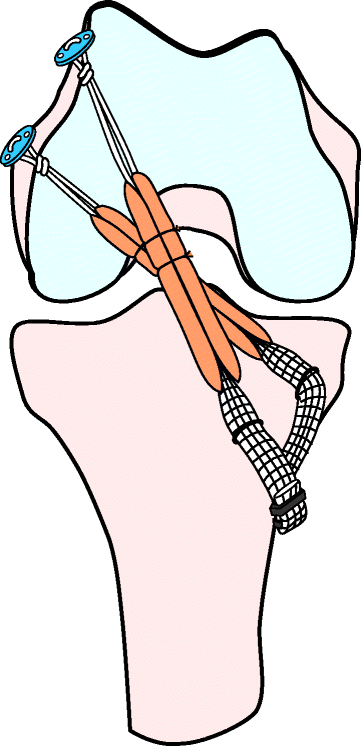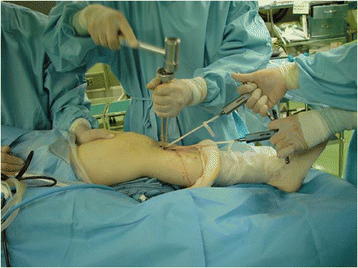Effects of initial graft tension on clinical outcome after anatomic double-bundle anterior cruciate ligament reconstruction: comparison of two graft tension protocols
- PMID: 26857109
- PMCID: PMC4746831
- DOI: 10.1186/s12891-016-0909-y
Effects of initial graft tension on clinical outcome after anatomic double-bundle anterior cruciate ligament reconstruction: comparison of two graft tension protocols
Abstract
Background: In anatomic double-bundle anterior cruciate ligament (ACL) reconstruction, there are great controversies concerning the ideal graft tension protocols. The purpose of this study was to clarify differences in the effect of two graft tension protocols on the clinical outcome after anatomic double-bundle anterior cruciate ligament (ACL) reconstruction by comparing the minimum 2-year clinical results.
Methods: Ninety-seven patients with unilateral anatomic double-bundle ACL reconstruction were divided into two groups. In the first 44 patients (Group I), a 40-N tension was applied to each of the two hamstring autografts at 30° of knee flexion, and simultaneously fixed onto the tibia. In the remaining 53 patients (Group II), a 30-N tension was applied to each graft at 10° of knee flexion, and simultaneously fixed onto the tibia. Each patient was examined 2 years after surgery.
Results: There wasn't a significant difference in the background of the two groups. There was no significant difference in the postoperative anterior laxity between the two groups. The average was 1.1 mm and 0.9 mm in Groups I and II, respectively. There wasn't any differences between the two groups in Lysholm knee score, International Knee Documentation Committee (IKDC) evaluation and muscle strength. Four patients had loss of knee extension in a range of 5° and 10° in Group I and none of the patients in Group II exhibited any loss in knee extension; which was statistically significant (p = 0.025).
Conclusion: The two initial graft tension protocols did not result in any significant differences in the Lysholm knee score and IKDC grade. However, it was noted that the 40-N tension applied to each graft at 30° of knee flexion more significantly induced loss of knee extension in comparison to the 30-N tension applied to each graft at 10°. From a clinical viewpoint, the loss of knee extension is one of the pathological conditions that should be absolutely avoided after ACL reconstruction. Therefore, the 30-N tension applied to each graft at 10° is preferable to the other graft tension protocol.
Figures



Similar articles
-
Gender-based differences in outcome after anatomic double-bundle anterior cruciate ligament reconstruction with hamstring tendon autografts.Am J Sports Med. 2011 Sep;39(9):1849-57. doi: 10.1177/0363546511408864. Epub 2011 Jun 23. Am J Sports Med. 2011. PMID: 21700783
-
Clinical evaluation of anatomic double-bundle anterior cruciate ligament reconstruction procedure using hamstring tendon grafts: comparisons among 3 different procedures.Arthroscopy. 2006 Mar;22(3):240-51. doi: 10.1016/j.arthro.2005.12.017. Arthroscopy. 2006. PMID: 16517306 Clinical Trial.
-
Effect of Initial Graft Tension on Knee Stability and Graft Tension Pattern in Double-Bundle Anterior Cruciate Ligament Reconstruction.Arthroscopy. 2015 Sep;31(9):1756-63. doi: 10.1016/j.arthro.2015.03.012. Epub 2015 Apr 22. Arthroscopy. 2015. PMID: 25911387
-
A meta-analysis of bone-patellar tendon-bone autograft versus four-strand hamstring tendon autograft for anterior cruciate ligament reconstruction.Knee. 2015 Mar;22(2):100-10. doi: 10.1016/j.knee.2014.11.014. Epub 2014 Dec 11. Knee. 2015. PMID: 25547048 Review.
-
The Results of Single Bundle Versus Double Bundle ACL Reconstruction Surgery, a Retrospective Study and Review of Literature.Med Arch. 2016 Oct;70(5):351-353. doi: 10.5455/medarh.2016.70.351-353. Epub 2016 Oct 25. Med Arch. 2016. PMID: 27994295 Free PMC article. Review.
Cited by
-
Graft Retensioning by Dialing of Suture Disk on Tibial-Side Fixation in Arthroscopic Anterior Cruciate Ligament Reconstruction: Pathak Pune Dialing Technique.Arthrosc Tech. 2020 Sep 9;9(9):e1291-e1298. doi: 10.1016/j.eats.2020.05.007. eCollection 2020 Sep. Arthrosc Tech. 2020. PMID: 33024669 Free PMC article.
-
Simultaneous medial closing wedge distal femoral varus osteotomy and double-bundle anterior cruciate ligament reconstruction in the symptomatic femoral valgus deformity: A case report.Jt Dis Relat Surg. 2024 Feb 13;35(2):422-432. doi: 10.52312/jdrs.2023.1176. Epub 2024 Feb 13. Jt Dis Relat Surg. 2024. PMID: 38727124 Free PMC article.
-
Restoring Knee Flexor Strength Symmetry Requires 2 Years After ACL Reconstruction, But Does It Matter for Second ACL Injuries? A Systematic Review and Meta-analysis.Sports Med Open. 2024 Jan 5;10(1):2. doi: 10.1186/s40798-023-00666-5. Sports Med Open. 2024. PMID: 38180584 Free PMC article.
-
Mechanical properties of a bioabsorbable magnesium interference screw for anterior cruciate ligament reconstruction in various testing bone materials.Sci Rep. 2023 Jul 31;13(1):12342. doi: 10.1038/s41598-023-39513-8. Sci Rep. 2023. PMID: 37524904 Free PMC article.
-
Evaluation of anterior cruciate ligament surgical reconstruction through finite element analysis.Sci Rep. 2022 May 16;12(1):8044. doi: 10.1038/s41598-022-11601-1. Sci Rep. 2022. PMID: 35577879 Free PMC article.
References
-
- Kondo E, Merican AM, Yasuda K, Amis AA. Biomechanical comparisons of knee stability after anterior cruciate ligament reconstruction between two clinically available trans-tibial procedures: anatomic double-bundle versus single-bundle. Am J Sports Med. 2010;38:1349–1358. doi: 10.1177/0363546510361234. - DOI - PubMed
-
- Yagi M, Wong EK, Kanamori A, Debski RE, Fu FH, Woo SL. Biomechanical analysis of an anatomic anterior cruciate ligament reconstruction. Am J Sports Med. 2002;30:660–666. - PubMed
-
- Yasuda K, Ichiyama H, Kondo E, Miyatake S, Inoue M, Tanabe Y. An in vivo biomechanical study on the tension-versus-knee flexion angle curves of 2 grafts in anatomic double-bundle anterior cruciate ligament reconstruction: effects of initial tension and internal tibial rotation. Arthroscopy. 2008;24:276–284. doi: 10.1016/j.arthro.2007.08.031. - DOI - PubMed
Publication types
MeSH terms
LinkOut - more resources
Full Text Sources
Other Literature Sources
Medical

